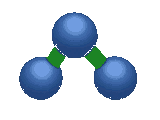 |
LABORATORIO DE FISICA DE LA ATMOSFERA | |
Universidad Mayor de San Andrés - La Paz Bolivia |
|
 |
LABORATORIO DE FISICA DE LA ATMOSFERA | |
Universidad Mayor de San Andrés - La Paz Bolivia |
|
OZONE STUDIES
INTRODUCTION
In 1839 Christian Friedrich Schoenbein discovered ozone gas (O3) a triatomic allotrope of oxygen (a form of oxygen in which the molecule contains three atoms instead of two as in the common form) made of molecules with a three oxygen atom structure.An irritating, strong smelling pale blue gas, ozone is explosive and toxic even at low concentrations, due to its strong reactivity. It occurs naturally in small amounts in the Earth's stratosphere, where it absorbs solar ultraviolet radiation, which otherwise could cause severe damage to living organisms on the Earth's surface.
In 1934, through ozone sounding, it was discovered that ozone is more abundant in the stratosphere. Even though the ozone layer is about 40 km thick, the total amount of ozone, compared with more abundant atmospheric gases, is quite small. If all of the ozone in a vertical column reaching up through the atmosphere were compressed to sea-level pressure, it would form a layer less than 3 millimetres thick. Contemporary measurements have shown that maximum ozone concentration levels are to be found depending on latitude between 15 and 30 km above sea level.
In the mid-1980s scientists discovered that a "hole" developed periodically in the ozonosphere above Antarctica; it was found that the ozone layer there was thinned by as much as 40-50 percent from its normal concentrations. This severe regional ozone depletion was explained as a natural phenomenon, but one that was probably exacerbated by the effects of chlorofluorocarbons and halons. As a result, the monitoring of the superficial ozone concentration has become an increasingly accepted and important indicator of contamination levels in big cities. Concern over increasing global ozone depletion, estimated to be 4% per decade, has led to a concentration of research into atmospheric ozone.
During the 1960s scientists working at the "Laboratorio de Física cosmica de Chacaltaya", carried out the first measurements and monitoring of the atmospheric ozone, in Bolivia, using sensors and sounding balloons. Since 1996, thanks to collaboration with Brazilian National Institute of Spatial Research (INPE), atmospheric ozone monitoring and measuring are carried out on a continual basis using a Brewer #110.
MAIN RESEARCH
A) STRATOSPHERIC OZONE: In addition to providing data for the South American ozone layer monitoring network our research has two main aims.
1) To research the ozone distribution over the geographically peculiar highlands of the Andes.
2) To monitor the superficial ozone of La Paz city in order to detect posible high levels of contamination.
1) Our study of the ozone layer involves the following:
1.1 Since July 1996 we have been monitoring the ozone layer over La Paz (16.5°S, 68.1°W, 3400m asl). The monitoring task is performed with a Brewer Spectrophotometer (Sci - Tec, Canada).
The measurements of the ozone layer are checked against the TOMS (NASA's satellite - borne instrument), which provides 'total ozone' data. We have also access to comparative data, in 30x30 resolution, from the NIMBUS satillite(1979-92) and currently from the EARTH PROBE (EPTOMS). Data relating to La Paz can be found on the NASA web page 'station OVP149'.
From the study of the variations of the total ozone column over our region, we have discovered an anomaly "mini ozone hole", which extends over the Andean Altiplano (ref. Zaratti et al., Nuovo Cimento vol.22, p.145, 1999, see publications). We are carrying out more research in the form of ozone soundings and more detailed study of the TOMS' data, in order to find an explanation for this anomaly.
The following picture shows the permanent and localised depletion of the ozone column over
the Altiplano. Data from TOMS.
(Image of the mini ozone hole, May 1992)
1.2 Ozono sounding campaigns, are being carried out in order to obtain data relating to the ozone profile of our altiplanic atmosphere. The following graphic shows the typical ozone profile; trophospheric values are as expected however, the shape and highness of the maximum suggest some unexpected and peculiar characteristics.
Photo of ozonesonde launching.
In order to better explain our data results theoretical studies are being carried out. Our studies relate the Andean mountain chain and bifurcation around the Altipano with the low values of ozone found over the altiplano.
2. SURFACE OZONE: The laboratory has been monitoring the UV-B levels at La Paz, since December 1995. These measurements are carried out using a biometer (Solar Light 501, USA) and two pyranometers (YES UVB-1, USA). The superficial ozone is seen mainly as a product of urban contamination and therefore it has a positive correlation with levels and concentrations of automobile gas emissions (the main air contamination source in La Paz). Our research purpose is twofold:
2.1 To monitor the surface ozone concentration and compare results with the Brewer's measurement of the ozone column.
2.2 To monitor contamination levels in La Paz city, in particular during the field/forrest burning season (Amazonic zones).
__________________________________________________________________________________________
| Main | UV | Gases | Meteorology | People | Publications | What's new|
___________________________________________________________________________________________